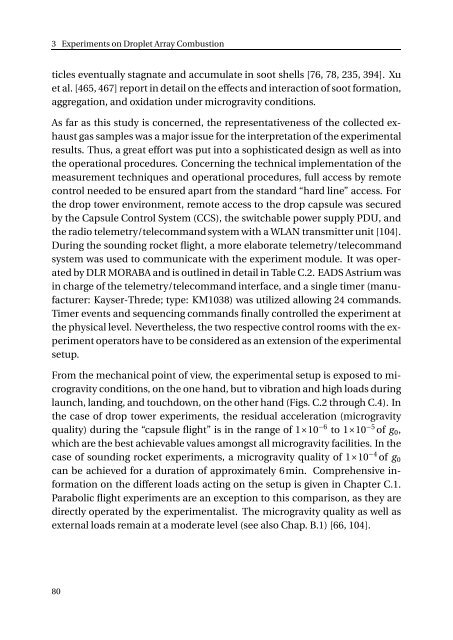On the Formation of Nitrogen Oxides During the Combustion of ...
On the Formation of Nitrogen Oxides During the Combustion of ...
On the Formation of Nitrogen Oxides During the Combustion of ...
You also want an ePaper? Increase the reach of your titles
YUMPU automatically turns print PDFs into web optimized ePapers that Google loves.
3 Experiments on Droplet Array <strong>Combustion</strong><br />
ticles eventually stagnate and accumulate in soot shells [76, 78, 235, 394]. Xu<br />
et al. [465, 467] report in detail on <strong>the</strong> effects and interaction <strong>of</strong> soot formation,<br />
aggregation, and oxidation under microgravity conditions.<br />
As far as this study is concerned, <strong>the</strong> representativeness <strong>of</strong> <strong>the</strong> collected exhaust<br />
gas samples was a major issue for <strong>the</strong> interpretation <strong>of</strong> <strong>the</strong> experimental<br />
results. Thus, a great effort was put into a sophisticated design as well as into<br />
<strong>the</strong> operational procedures. Concerning <strong>the</strong> technical implementation <strong>of</strong> <strong>the</strong><br />
measurement techniques and operational procedures, full access by remote<br />
control needed to be ensured apart from <strong>the</strong> standard “hard line” access. For<br />
<strong>the</strong> drop tower environment, remote access to <strong>the</strong> drop capsule was secured<br />
by <strong>the</strong> Capsule Control System (CCS), <strong>the</strong> switchable power supply PDU, and<br />
<strong>the</strong> radio telemetry/telecommand system with a WLAN transmitter unit [104].<br />
<strong>During</strong> <strong>the</strong> sounding rocket flight, a more elaborate telemetry/telecommand<br />
system was used to communicate with <strong>the</strong> experiment module. It was operated<br />
by DLR MORABA and is outlined in detail in Table C.2. EADS Astrium was<br />
in charge <strong>of</strong> <strong>the</strong> telemetry/telecommand interface, and a single timer (manufacturer:<br />
Kayser-Threde; type: KM1038) was utilized allowing 24 commands.<br />
Timer events and sequencing commands finally controlled <strong>the</strong> experiment at<br />
<strong>the</strong> physical level. Never<strong>the</strong>less, <strong>the</strong> two respective control rooms with <strong>the</strong> experiment<br />
operators have to be considered as an extension <strong>of</strong> <strong>the</strong> experimental<br />
setup.<br />
From <strong>the</strong> mechanical point <strong>of</strong> view, <strong>the</strong> experimental setup is exposed to microgravity<br />
conditions, on <strong>the</strong> one hand, but to vibration and high loads during<br />
launch, landing, and touchdown, on <strong>the</strong> o<strong>the</strong>r hand (Figs. C.2 through C.4). In<br />
<strong>the</strong> case <strong>of</strong> drop tower experiments, <strong>the</strong> residual acceleration (microgravity<br />
quality) during <strong>the</strong> “capsule flight” is in <strong>the</strong> range <strong>of</strong> 1×10 −6 to 1×10 −5 <strong>of</strong> g 0 ,<br />
which are <strong>the</strong> best achievable values amongst all microgravity facilities. In <strong>the</strong><br />
case <strong>of</strong> sounding rocket experiments, a microgravity quality <strong>of</strong> 1×10 −4 <strong>of</strong> g 0<br />
can be achieved for a duration <strong>of</strong> approximately 6min. Comprehensive information<br />
on <strong>the</strong> different loads acting on <strong>the</strong> setup is given in Chapter C.1.<br />
Parabolic flight experiments are an exception to this comparison, as <strong>the</strong>y are<br />
directly operated by <strong>the</strong> experimentalist. The microgravity quality as well as<br />
external loads remain at a moderate level (see also Chap. B.1) [66, 104].<br />
80
















